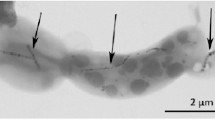Abstract
Alphaproteobacteria of the genus Magnetospirillum use dedicated organelles, the magnetosomes, to navigate along geomagnetic field lines in their natural environment. Magnetosomes are nanocrystals of magnetite (Fe3O4) which are biomineralized within specific membrane vesicles and become aligned into chains by a dedicated cytoskeleton. This article also highlights the potential for functionalization and application of these bacterial magnetic nanoparticles.
Similar content being viewed by others
Referenzen
Schleifer K-H, Schüler D, Spring S et al. (1991) The genus Magnetospirillum gen. nov. description of Magnetospirillum gryphiswaldense sp. nov. and transfer of Aquaspirillum magnetotacticum to Magnetospirillum magnetotacticum comb. nov. Syst Appl Microbiol 14:379–385
Uebe R, Schüler D (2016) Magnetosome biogenesis in magnetotactic bacteria. Nat Rev Micro 14:621–637
Raschdorf O, Forstner Y, Kolinko I et al. (2016) Genetic and ultrastructural analysis reveals the key players and initial steps of bacterial magnetosome membrane biogenesis. PLoS Genet 12:e1006101
Uebe R, Keren-Khadmy N, Zeytuni N et al. (2018) The dual role of MamB in magnetosome membrane assembly and magnetite biomineralization. Mol Microbiol 107:542–557
Li Y, Raschdorf O, Silva KT et al. (2014) The terminal oxidase cbb3 functions in redox control of magnetite biomineralization in Magnetospirillum gryphiswaldense. J Bacteriol 196:2552–2562
Li Y, Katzmann E, Borg S et al. (2012) The periplasmic nitrate reductase Nap is required for anaerobic growth and involved in redox control of magnetite biomineralization in Magnetospirillum gryphiswaldense. J Bacteriol 194:4847–4856
Toro-Nahuelpan M, Müller FD, Klumpp S et al. (2016) Segregation of prokaryotic magnetosomes organelles is driven by treadmilling of a dynamic actin-like MamK filament. BMC Biol 14:88
Popp F, Armitage JP, Schüler D (2014) Polarity of bacterial magnetotaxis is controlled by aerotaxis through a common sensory pathway. Nat Commun 5:5398
Nordmann GC, Hochstoeger T, Keays DA (2017) Magnetoreception–a sense without a receptor. PLoS Biol 15:e2003234
Mickoleit F, Schüler D (2017) Generation of multifunctional magnetic nanoparticles with amplified catalytic activities by genetic expression of enzyme arrays on bacterial magnetosomes. Adv Biosys, doi: 10.1002/adbi.201700109
Kraupner A, Eberbeck D, Heinke D et al. (2017) Bacterial magnetosomes–nature’s powerful contribution to MPI tracer research. Nanoscale 9:5788–5793
Le Fèvre R, Durand-Dubief M, Chebbi I et al. (2017) Enhanced antitumor efficacy of biocompatible magnetosomes for the magnetic hyperthermia treatment of glioblastoma. Theranostics 7:4618–4631
Kolinko I, Lohße A, Borg S et al. (2014) Biosynthesis of magnetic nanostructures in a foreign organism by transfer of bacterial magnetosome gene clusters. Nat Nanotech 9:193–197
Author information
Authors and Affiliations
Corresponding author
Additional information
René Uebe 2001–2006 Biologiestudium an der Universität Greifswald; 2007–2012 Promotion und 2012–2014 Postdoc an der LMU München. Seit 2014 Akademischer Rat auf Zeit und Gruppenleiter am Lehrstuhl für Mikrobiologie der Universität Bayreuth.
Dirk Schüler 1990 Biologie-Diplom an der Universität Greifswald. 1994 Promotion in München, Postdoc-Aufent halte an der Iowa State University und dem Scripps Institute of Oceanography, La Jolla, CA, USA. Ab 1999 Nachwuchsgruppenleiter am Max-Planck-Institut für Marine Mikrobiologie in Bremen. 2006 Professor an der LMU München. Seit 2014 Lehrstuhlinhaber für Mikrobiologie an der Universität Bayreuth.
Rights and permissions
About this article
Cite this article
Schüler, D., Uebe, R. Nanokristalle für die Magnetfeldorientierung – Biogenese von Magnetosomen. Biospektrum 25, 22–25 (2019). https://doi.org/10.1007/s12268-019-0997-y
Published:
Issue Date:
DOI: https://doi.org/10.1007/s12268-019-0997-y




